Clannad: A Review – Glass Reflection
There comes a time while watching anime when you will finish watching a particular show and be in a sort of euphoria. The journey that the show took you on was extraordinary. You felt an attachment to the characters, like you were actually inside of the world that was presented to you, and it was an experience that you may find hard to describe. But now that it is over, you don’t know what to do. You look around and people are moving on, oblivious to the things you have seen and the world you have experienced.
If you know of what I speak, then you know what it is to finish a truly great anime. But not just anime though. You can get these feelings from any kind of show, as long as it speaks to you somehow. The story could be about time travel, a mystic world in an alternate universe, a land beyond your imagination or comprehension. But sometimes, that story could be a lot simpler, a kind of story that you’ve seen many a time before, but perhaps not in this particular way. Ladies, gentlemen, and others, my name is Arkada and welcome to Glass Reflection. Today, we will be talking about an anime that is very close to my heart. Yes, today I am talking about Clannad and Clannad: After Story.
Steemit disclaimer: As I have a relatively large backlog of content to move over to Steemit, some of the details in this video/transcript may be slightly out-of-date. Please forgive these details, because I still feel like these reviews are worth sharing despite this.
The Story
Clannad is the final third in what I refer to as the Key/Kyoto Ani Holy Trinity. The Holy Trinity is a series of Key’s visual novels that have been adapted by Kyoto Animation. It consists of Air, Kanon 2006, and of course Clannad, all of which share a surprising number of similarities, including art styles with eyes as big as their hands, character traits borderlining on the completely fantastical, and plotlines not entirely realistic from mystic curses to shape-shifting females. Above all, they all have moments that will make you sad and depressed as fuck. So!
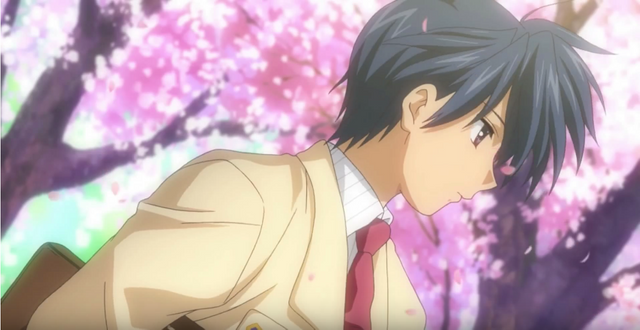
The story of Clannad specifically is not too much different from your typical visual novel. You have your main male protagonist, in this case Tomoya, who over the course of the series becomes surrounded by a group of females, all with different traits, personalities, and well, problems. It ends up being Tomoya’s job to become a figurative wizard and solve all the problems so that everyone is happy. But that’s a problem. As some of you may know, in visual novels, you have to make choices. These choices lead you down several paths, usually one for each major female, and you follow these paths to reach the perfect happy ending with that specific girl. But in the visual novel, you can only focus on one girl at a time and then you have to restart from the beginning.
In the adaptation however, Tomoya can only have one girl by the end of it, so then the stories change to accommodate this fact. This changes romantic plotlines into ones where they just become friends, and this is fine depending on how much of the original story relied more on the romance or if there were some other elements upon which it could focus. In other words, sometimes it worked, other times not so much.
The Characters
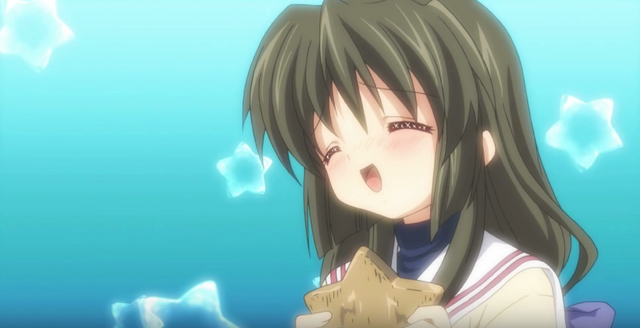
Let’s go in order of the arcs without spoiling too much, shall we? Starting off the list is Fuko. Fuko is a young girl obsessed with starfish. No, I’m serious, she’s really obsessed with starfish. But she is a girl on a mission, and that mission is to attempt to get as many people as possible to her sister’s wedding. So Fuko carves out wooden starfish as invitations and hands them out to as many people as possible before the faithful day. One problem though: as time passes, people seem to forget about Fuko and her starfish, like she was never there. Like she never existed. Ooooooohhhhh.
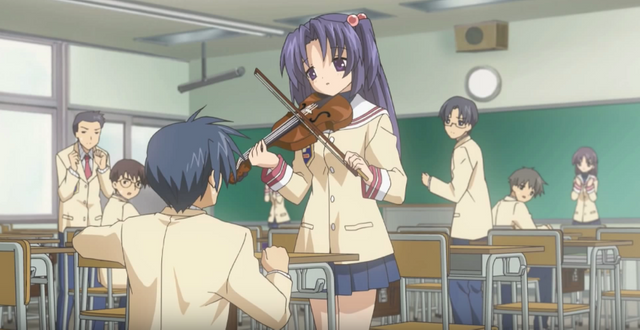
Next up is Kotomi, an exceptionally quiet girl who has grades that far surpass her peers, although she is heavily lacking in social skills. She spends the majority of her days alone in the library, and it isn’t until Tomoya stumbles across her one day that she gets more socially active and Tomoya becomes one of her first friends. But she has a past that she wants to forget about, an event that changed her life from then on, one that she does not want to face.
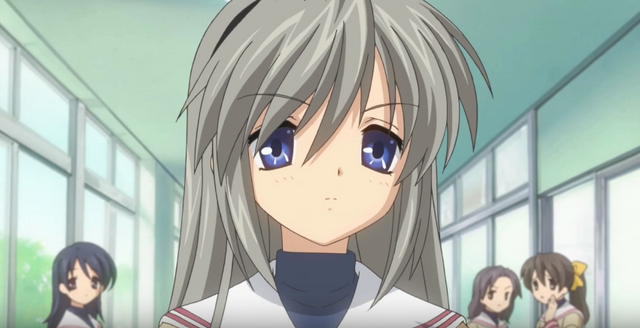
We also have Tomoyo, a figurative ice queen, rumoured to have once been the leader of a gang outside of the school, and her prowess in fighting does nothing to dispute that. Although she appears like a complete and total ice queen, she is actually very kind-hearted, working towards the noble goal of becoming student council president in order to stop the demolition of the nearby sakura trees to which she has a personal attachment. But unfortunately, she also has a history that she cannot walk away from, one that may end her plans before she even has a chance to enact them.
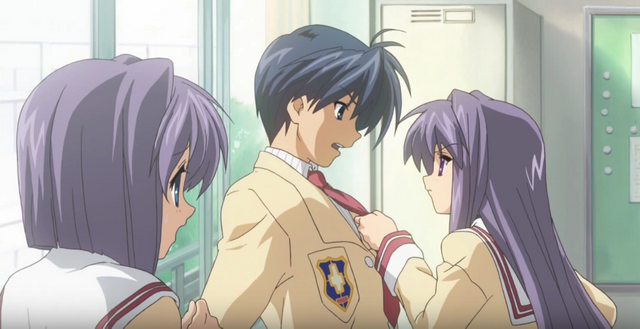
Then there are the twins, Kyou and Ryou. Kyou is an over-reactive tsundere with a bad habit of unnecessarily causing physical violence, usually to a hilarious degree. Her sister Ryou happens to have a very obvious crush on our main protagonist Tomoya, but is unfortunately the extremely shy character of the series and does not know how to properly express her feelings, even though she is helped along by her sister, who may or may not also have feelings for him. Admittedly, neither of the twins get a proper arc in the series, almost to the point of being delegated to the supporting character role the entire time. Thankfully, she (as well as Tomoyo) happen to get their own bonus OVA episodes at the end of each season, in which the regular storyline is forgotten and Tomoya becomes their boyfriend. It’s sort of a ‘what if’ scenario to pad out what had to get cut from the visual novel in the main storyline, because in the main storyline we have the final female protagonist, Nagisa.
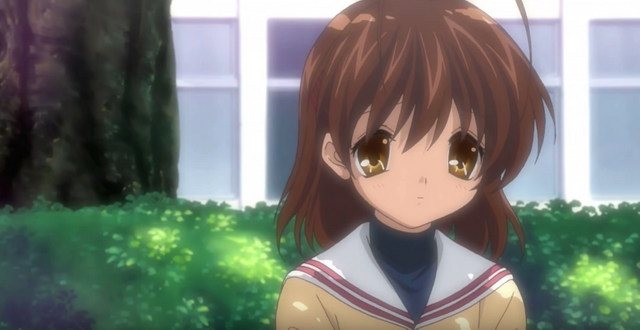
Although she does not look or act like it, Nagisa is older than the rest and is repeating a grade. She has a history of poor health that causes her to be absent from school for long periods of time, so much so that she becomes unable to graduate. But she lives on regardless and, with the help of Tomoya, she works towards her goal of restarting the school’s drama club and putting on a performance for the yearly school festival. Out of all the females, Nagisa is the one with the most screen time, though she isn’t always in the spotlight. This allows her story to be the most fleshed out and Nagisa herself becomes heavily involved with Tomoya in the other girls’ arcs to help give her a fair bit of character development, because they want you to get emotionally attached to her. The more attached you are, the worse it hurts when they hit you over the head with the metaphorical baseball bat later on.
The supporting characters also deserve mention, from Nagisa’s parents, Fuko’s sister, and of course Tomoya’s best friend Sunohara, who spends the entire show as the comic relief punching bag, making idiotic statements that usually get him heavily beat up for the amusement of all.
But when comparing Clannad to other Kyoto Ani works such as Kanon, I do have to admit that where the story and characters are concerned, I do prefer Kanon in a lot of ways. But Clannad has one thing that makes it so much better.
After Story
One of the main problems that I have with most romantic anime is how far they are willing to take the main story. When the romance is only a side-plot, you’re lucky if the characters even get together, let alone do anything together as a couple. And even when the romance is the focal point, you might only get a kiss. Beyond that though? Yeah, not happening. Those shows spend so much time getting their characters to first base that, by the time they get there, the show is over. But that, my dear people, is where Clannad becomes glorious.
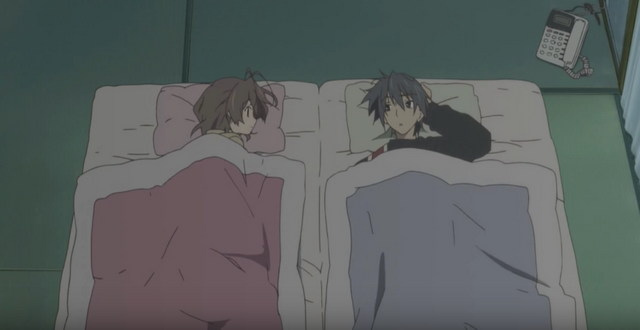
Clannad: After Story is quite literal in its title in that it takes place after the regular story. Most of the main characters from the first season have graduated from high school, found jobs and go about living their life, and it is the story of the trials and tribulations of life beyond high school. That’s one of the reasons why I love it so much, because usually you don’t see this sort of continuation. Normally nothing exists beyond high school. Hell, even when you’re dead, you go back to high school or the dead come to you, either or. So because of this, all of the female characters of the original season are out of the way and Tomoya and Nagisa can begin their lives together. They move in, Tomoya gets a job, they do other things, and everything is fine and dandy. But that all helps tie into the saddest second half of any anime ever. Well, so far anyway.
If you’ve watched either Air and Kanon before, then you should know by now that sadness in these particular shows is standard fare. Although, unlike Air and Kanon, who just hit you once with the metaphorical baseball bat of emotion, After Story does not know when to stop hitting you, so much so that the only people who can survive its emotional onslaught are those with the heart of a brick or those who are just plain dead. Well, maybe that’s being a bit unfair. There are reasons as to why someone might not get emotionally attached to this show.
The Animation
The character designs for Clannad are par for the course, considering the show’s genre as well as Kyoto Animation’s history for heavily moe infected characters. I would argue however that in terms of design, the characters are another thing that I think Kanon did better. This is more so a fault of the original character designers for the visual novel rather than anyone at Kyoto Ani, and I do realize that there is only so much you can do with characters who are all supposed to be wearing the same school outfits. But seriously, having three main characters with slightly different shades of purple hair? Come now, you can do better than this. In fact, you have. It’s called Kanon.
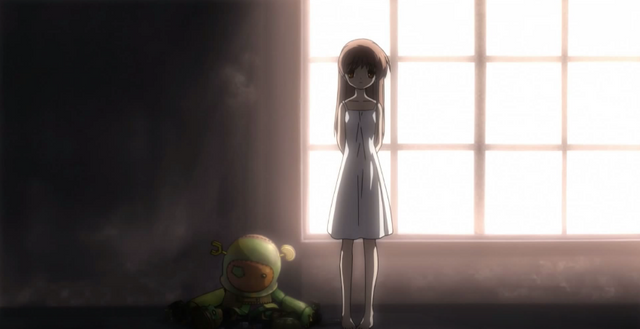
Where Clannad does completely shine however is in the actual animation department. While for the majority of the show the animation can be considered standard fare (though obviously with Kyoto Animation’s usually high production value), interspliced with the regular story of Clannad is a second, almost side story involving a young girl and a small robot in a world without people. These sections themselves do eventually lead to a resolution that does relate to the main plot in the end, but it’s the animation of these particular scenes that far exceed that of the rest of the show, and I would argue that it is also some of Kyoto Ani’s best animation work to date. Suck it, K-On! That’s right, I said it. Whatcha gonna do?
The Sound
Like most Key adaptations, or rather like all Key adaptations, the music for Clannad was done by Jun Maeda. As such, most of the tracks are just reiterations of the original visual novel themes and, while they do fit the scenes rather well, none of them really stand out. The exceptions are of course the openings, endings, and one of my favourite songs titled The Girl’s Fantasy, which is usually played during the aforementioned girl and robot scenes, and then again near the end of the series in some of the more emotional scenes of the show, helping to perfectly encapsulate the emotional rollercoaster that the show becomes.
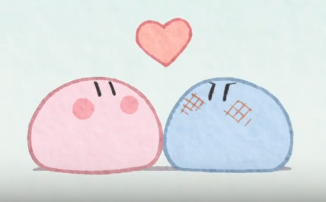
Now the other problem I have sound-wise would be the dub. Recall back to my thoughts on the Kanon dub, where I stated that English voice actors have a very hard time with moe characters and they just don’t sound right in those roles. While Air was somehow able to side-step that problem with the help of Monica Rial and Luci Christian, Clannad has this problem coming right back full tilt. Although thankfully, unlike Kanon, there are some notable performances. Luci Christian and Hillary Hagg as Nagisa and Fuko are great examples of moe done well in English. Everything beyond that though is hit or miss depending on your tastes.
I would also like to point out another problem I had dub-wise. I know that I am not one who is very good at pronouncing Japanese names or words correctly, something which many people tell me constantly. But when I spend who knows how many hours of my life watching this show in Japanese with a character called NA-gi-sa, it really starts to get on my nerves when the English dub refers to her as na-GEE-sa. You’re putting emphasis on the incorrect syllable, and it’s frustratingly annoying. Now I do know how other people feel when I get the names wrong. So I suppose you can add this dub to a list of dubs from Sentai Filmworks that I just really do not care for – although so far that list includes all of them. I’m blaming Steven Foster for this one, but that’s just me. I find it hard to believe that it’s the fault of the actors when most of them have done exceedingly well in other dubs.
Final Verdict
There are some people who would argue that the combination of Clannad and Clannad: After Story creates one of the greatest romantic dramas that we have ever seen in an anime, and in some respects I’m inclined to agree with them. It dabbles into a side of relationships that very few, if any, other romantic anime dare to tread. And it does so with such skill to keep us invested in these characters even as the story tries to rip our hearts out from our chests. It’s not perfection however.
Early on, specifically in the first season, the plot has a very hard time breaking away from its visual novel roots, placing focus on each female character in order while throwing the rest of them out of the spotlight, especially with our main female Nagisa stuck in her supporting character role for the majority of that season, regardless of the fact that she is the main female lead. Aspects of the character designs can be a bit much for some people, and if you want and/or expect a story that’s entirely based in reality without any supernatural or fantastical elements, then you may not enjoy this show to its full potential. Just bring a tissue box with you when you do watch it and know that everything is going to be alright. You will get through this. I believe in you.
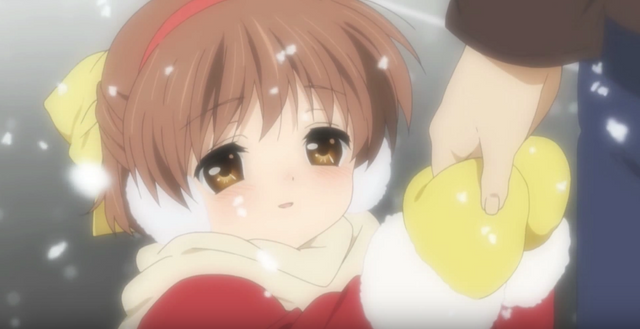
Now, the ending of this show may not be what you hope it to be. I know some people who are right turned off by it. Though considering many aspects of the original visual novel ending were heavily dependent on the mechanics of visual novels, that’s not entirely surprising. It’s not a clean cut ending, but to me, it was satisfying, so much so that the ending of Clannad: After Story was the very ending that helped me to solidify my belief that the ending of any show is paramount. Hopefully, when you watch it, you will agree.
With all of that in mind, I have meticulously calculated values for the categories of story, characters, animation, sound, and my own personal enjoyment, which – after locking it into an endless time loop with the purpose of gathering happiness from all the various could-have-been’s – leaves me awarding Clannad and Clannad: After Story with a combined score of 9.44 out of ten, and rating this series Certified Frosty, a rating for only the best of the best and those shows too important to ignore.

At the time of this video, Clannad is not available for legal streaming, however it has been licensed and is available from Sentai Filmworks. Though I will admit, their particular release of the series has not been, shall we say, of the best quality. But the show itself is worth having and supporting the creators is always the best option, even if you end up using fansubs when you actually watch the show. For alternate anime recommendations, besides the obvious other Holy Trinity titles Air and Kanon 2006, I also recommend the romantic dramas Toradora and EF Tale of Memories, both of which have their moments of emotional torment and also stand as some of the best in their genre.
With that, I leave you. After over four years, three websites, and one hundred videos – ladies, gentlemen and others – my name is Arkada and this has been Glass Reflection. Until next time, stay frosty, and here’s to one hundred more.

dango, dango, *sniff * I'm not crying, you're crying!
Btw another great title on your list of reviews, there is a reason why this show sits in the top anime list of MAL despite it airing a decade ago. But the first season may be somewhat of a hurdle, for me at least, as the show actually got more interesting in the after story after the twists and the introduction of Ushio.
Nevertheless taken as a whole, this is a show that I would also refer to people seeking a beautiful and touching story in anime.
dango dan go dango dango dango daikazoku...
This song manages to get from extremely annoying to "oops, I sang it again in the us", the more you hear it.
Maid-chan wonders how this can happen.
That's the magic of anime songs especially when they can invoke the feelings that the series has given us, the viewers, when we watched it. The memories will start to come back and you'll be left with a feeling of nostalgia of the good ol' times lol.
This post was shared in the Curation Collective Discord community for curators, and upvoted and resteemed by the @c-squared community account after manual review.
Maid-chan approves of this review and has resteemed it.
Congratulations @grarkada! You have completed some achievement on Steemit and have been rewarded with new badge(s) :
Click on the badge to view your Board of Honor.
If you no longer want to receive notifications, reply to this comment with the word
STOPDo not miss the last post from @steemitboard!
Participate in the SteemitBoard World Cup Contest!
Collect World Cup badges and win free SBD
Support the Gold Sponsors of the contest: @good-karma and @lukestokes